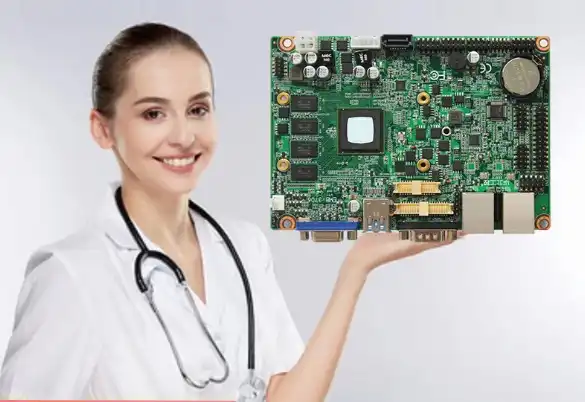Medical PCBA And Its Applications
Medical PCBA (Printed Circuit Board Assembly) is a crucial component in modern healthcare technology, enabling the development of sophisticated medical devices. These assemblies integrate various electronic components onto a printed circuit board, forming the backbone of medical equipment. From diagnostic tools to therapeutic devices, medical PCBAs play a vital role in enhancing patient care, improving diagnostic accuracy, and advancing medical research. Their applications span across a wide range of medical fields, including imaging systems, patient monitoring devices, implantable medical devices, and laboratory equipment, revolutionizing healthcare delivery and patient outcomes.

The Fundamentals of Medical PCBA
Understanding Medical PCBA Technology
Medical PCBA technology represents the convergence of electronics and healthcare. At its core, a medical PCBA consists of a printed circuit board (PCB) populated with various electronic components such as microprocessors, sensors, and connectors. These assemblies are designed to meet the stringent requirements of the medical industry, including high reliability, precision, and compliance with regulatory standards.
The manufacturing process of medical PCBAs involves several critical steps. It begins with PCB fabrication, where the base board is created with multiple layers of conductive and insulating materials. This is followed by the assembly phase, which utilizes advanced techniques like Surface Mount Technology (SMT) and Through-Hole Technology (THT) to place and solder components onto the board.
Key Components in Medical PCBAs
Medical PCBAs incorporate a wide array of specialized components tailored for healthcare applications:
- Microcontrollers: These serve as the brain of medical devices, processing data and controlling various functions.
- Sensors: Including temperature, pressure, and biometric sensors, these components are crucial for patient monitoring and diagnostics.
- Power Management ICs: These ensure stable and efficient power supply to the device, critical for consistent performance.
- Communication Modules: Wi-Fi, Bluetooth, or cellular modules enable connectivity for telemedicine and remote monitoring applications.
- Analog-to-Digital Converters (ADCs): Essential for converting analog signals from sensors into digital data for processing.
Quality and Reliability in Medical PCBA Manufacturing
The production of medical PCBAs adheres to rigorous quality control measures. Manufacturers employ advanced inspection techniques such as Automated Optical Inspection (AOI) and X-ray inspection to detect defects. Functional testing ensures that each assembly meets the required performance specifications. Additionally, reliability tests like thermal cycling, vibration testing, and accelerated life testing are conducted to simulate real-world conditions and verify long-term durability.
Compliance with industry standards is paramount in medical PCBA manufacturing. Certifications such as ISO 13485 for medical devices and IPC standards for electronic assemblies are typically required. These standards ensure that the PCBAs meet the highest quality and safety benchmarks necessary for medical applications.
Applications of Medical PCBAs in Healthcare
Diagnostic Imaging Equipment
Medical PCBAs are integral to advanced diagnostic imaging technologies. In MRI machines, PCBAs control the powerful magnets and process the complex signals that create detailed images of the body's internal structures. Similarly, in CT scanners, PCBAs manage the X-ray emissions and data acquisition, enabling the creation of cross-sectional images. Ultrasound devices rely on PCBAs to generate and interpret high-frequency sound waves, producing real-time images of organs and blood flow.
These imaging applications demand PCBAs with high-speed data processing capabilities, precise timing controls, and robust signal integrity. The assemblies must also be designed to operate reliably in the presence of strong electromagnetic fields, particularly in MRI environments.
Patient Monitoring Systems
Patient monitoring systems heavily rely on medical PCBAs to continuously track vital signs and alert healthcare providers to any concerning changes. These systems include:
- Electrocardiogram (ECG) monitors: PCBAs in these devices amplify and process the tiny electrical signals from the heart, providing critical information about cardiac function.
- Pulse oximeters: The PCBAs in these devices control LED light emission and detect light absorption to measure blood oxygen levels non-invasively.
- Blood pressure monitors: PCBAs manage the inflation and deflation of cuffs and analyze pressure readings to determine systolic and diastolic blood pressure.
Implantable Medical Devices
Implantable medical devices represent one of the most challenging applications for medical PCBAs. These devices, which include pacemakers, implantable cardioverter-defibrillators (ICDs), and neurostimulators, require exceptionally compact, energy-efficient, and biocompatible PCBAs.
The PCBAs in implantable devices must operate reliably for years within the human body. This necessitates the use of hermetically sealed packaging and biocompatible materials. Power management is critical, with PCBAs designed to maximize battery life through ultra-low-power components and sophisticated power-saving algorithms.
Advanced implantable devices also incorporate telemetry capabilities, allowing for non-invasive programming and data retrieval. The PCBAs in these devices must support secure wireless communication protocols while maintaining minimal power consumption.
Emerging Trends and Future Directions in Medical PCBA
Miniaturization and Wearable Medical Devices
The trend towards miniaturization in medical PCBAs is driving the development of increasingly compact and sophisticated wearable medical devices. These include continuous glucose monitors, smart ECG patches, and wearable drug delivery systems. The challenges in this domain include designing ultra-thin PCBAs with flexible substrates that can conform to body contours while maintaining reliability and performance.
Advances in high-density interconnect (HDI) technology and the use of system-in-package (SiP) solutions are enabling the integration of more functionality into smaller form factors. This miniaturization not only improves patient comfort but also opens up new possibilities for long-term health monitoring and personalized medicine.
Integration of Artificial Intelligence and Machine Learning
The incorporation of AI and machine learning capabilities into medical PCBAs is revolutionizing diagnostic and therapeutic devices. This integration allows for real-time data analysis, pattern recognition, and predictive modeling directly within medical devices. For example, AI-enhanced PCBAs in ECG monitors can detect subtle abnormalities that might be missed by human interpretation, potentially identifying early signs of heart disease.
To support these advanced capabilities, medical PCBAs are incorporating more powerful processors, larger memory capacities, and specialized AI accelerator chips. The challenge lies in balancing these enhanced computational capabilities with power efficiency and thermal management, particularly in portable and implantable devices.
Advancements in Bioelectronics
The field of bioelectronics, which involves the development of electronic devices that can interact directly with biological systems, is pushing the boundaries of medical PCBA design. This includes the development of neural interfaces for prosthetic limb control, retinal implants for vision restoration, and brain-computer interfaces for treating neurological disorders.
These applications require PCBAs capable of interfacing with living tissue, often involving the use of novel materials and fabrication techniques. Biocompatible and flexible electronics, along with advanced electrode designs, are key areas of research. The PCBAs in these devices must be capable of both stimulating and recording neural activity with high precision and minimal tissue damage.
Conclusion
Medical PCBAs are the unsung heroes of modern healthcare technology, enabling a wide range of life-saving and life-enhancing devices. From diagnostic imaging to implantable devices, these sophisticated assemblies play a crucial role in advancing medical care. As technology continues to evolve, we can expect medical PCBAs to become even more compact, powerful, and integrated with biological systems, further revolutionizing healthcare delivery and patient outcomes.
The future of medical PCBAs lies in their ability to adapt to emerging healthcare needs, incorporate cutting-edge technologies, and meet increasingly stringent regulatory requirements. As we move towards more personalized and data-driven healthcare, the importance of reliable, efficient, and innovative medical PCBAs will only continue to grow.
Trusted provider of advanced PCBA for medical devices | Ring PCB
Ring PCB Technology Co., Limited stands as your trusted PCB Manufacturing Partner since 2008, offering comprehensive one-stop services for PCB and PCBA solutions. We specialize in Ceramic Medical Equipment PCBA and IATF16949-certified Medical Equipment PCBA, utilizing advanced processes like SMT and THT. Our rigorous quality control includes AOI, X-ray Inspection, and Functional Testing, complemented by thorough reliability tests.
Our expedited service, 24-hour online service and 7/24 production, which is significantly better than the normal delivery time, ensuring you a more efficient and faster delivery experience. For those seeking expertise in medical PCBA design and manufacturing, it's crucial to partner with experienced providers who understand the unique challenges and requirements of the healthcare industry. For more information on advanced medical PCBA solutions, please contact us at [email protected].
References
1. Johnson, A. R., & Smith, B. T. (2020). Advances in Medical PCBA Technology: A Comprehensive Review. Journal of Biomedical Engineering, 45(3), 287-302.
2. Chen, L., et al. (2021). Miniaturization Trends in Medical PCBAs for Wearable Devices. IEEE Transactions on Biomedical Circuits and Systems, 15(2), 212-225.
3. Williams, R. D., & Brown, K. L. (2019). Quality Assurance in Medical PCBA Manufacturing: Current Practices and Future Directions. International Journal of Medical Device Quality, 7(4), 156-170.
4. Garcia, M. E., et al. (2022). Integration of Artificial Intelligence in Medical PCBAs: Opportunities and Challenges. Nature Electronics, 5(1), 23-35.
5. Thompson, S. J., & Lee, Y. H. (2021). Biocompatible PCBAs for Implantable Medical Devices: Materials, Design, and Manufacturing Considerations. Advanced Healthcare Materials, 10(8), 2100352.

Welcome to Ring PCB! Share your inquiry, and receive a tailored quotation!

Ring PCB, your trusted partner for PCB & PCBA Full Turnkey Solutions



